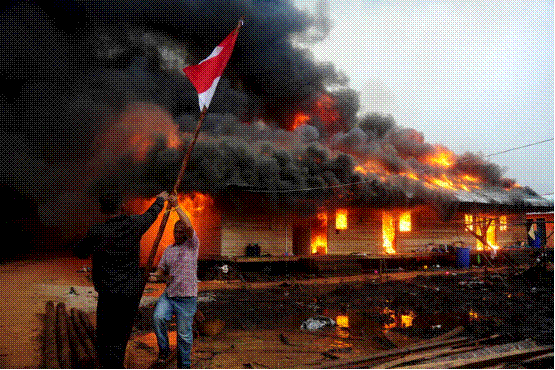
A mob burnt down a compound of a religious cult in West Kalimantan, Indonesia. Reuters/Antara Photo Agency
In a small regency in West Kalimantan, Indonesia, more than 1000 members of a new religious sect called Gafatar have set up a commune over the past year. Most of them, including a general practitioner who was reported missing in late December with her daughter, have moved from Java in the past year.
In late January, a mob attacked and burned down their houses. Human rights activists condemned the attack and called for the government to protect Gafatar members.
But a lot of people in Indonesia, the world’s most populous Muslim country, were also puzzled by the news that young professionals were joining a cult that reportedly mixes elements of Islam, Christianity and Judaism.
Gafatar falls into what religious scholars call “new religious movements”. Why and how do such movements emerge? And how should the government deal with emerging religious cults while ensuring religious freedom of all citizens?
New religious movements
New religious movements, such as Gafatar, usually fit these criteria:
· are a collective with a charismatic leader;
· actively yet discreetly recruit new members;
· have a hierarchical structure similar to a traditional religion;
· have a religious doctrine that tends to be different from conventional religions; and
· isolate themselves from mainstream society by building a new life order (as Gafatar has done by moving to Mempawah).
Some experts view these movements as representing new interpretations of established religions. Other researchers see it as a response to disillusionment with social and political conditions.
In Indonesia, the transition from the authoritarian Suharto regime to the current democratic system has created an atmosphere of uncertainty and instability. This kind of social instability may influence the emergence of groups that offer instant solutions in the form of personal relationships and eschatological promises, eliminating or at least reducing the feelings of uncertainty.
Some people may be attracted to these groups as they consider established religions have failed. They may feel these religions are focused on the past and can no longer provide guidance in solving social problems. Additionally, they may feel established religions have rigid, unattractive and scary rules.
New religious movements usually evolve in a certain pattern. They start by offering to refresh people’s understanding of religious teachings. This is followed by suggestions of a new way of seeing the established religion. Then they justify the possibility of a different view from the established religion. In the end, followers are encouraged to separate from the parent religion.
Almost all new religious movements undergo this metamorphosis. Some manage to become new established religions, like Bahá'ism, but often the movements disappear with the death of a leader, internal conflict, or because it was banned by a regime.
Dealing with new religious movements
There are many types of new religious movements. Some are pacifists, focused on mobilising followers in a peaceful way. Some are extremists.
The US Branch Davidian sect led by David Koresh in Waco, Texas, or the Aum Shinrikyo sect led by Shoko Asahara in Japan shows how these movements can resort to extreme actions when they cannot find a compromise with established religion or authorities.
The Branch Davidians chose armed conflict with the police. Aum Shinrikyo released sarin poison in Tokyo’s subway.
These cults are able to mobilise people to carry out extreme actions due to followers' obedience to the leader. This is one of the concerns about the emergence of a new religious movement: the potential harm, as a consequence of blind faith in charismatic leaders, that might result from these movements.
Nevertheless, the Indonesian government should guarantee religious freedom to anyone, including members of religious minorities. Perpetrators of violence, including those who attacked the Gafatar camp, should be brought to justice.
Government officials and law enforcement officers who allowed violence to happen by merely standing by, or who were actively involved in attacks, should be punished.
Indonesia’s law allows the government to control religious life in the public sphere. The government can limit certain freedoms in public matters if necessary. But it should do so in line with public interests and fairness.
In dealing with new religious movements, the government should investigate whether a movement has the potential to jeopardise public order before taking action against it.
The government should ban an organization that preaches violence, allows child marriages or incest, declares a separatist intention, or aims to change the country’s constitution into a religious-based one.
Most of the time, attackers of unorthodox religious sects get away with carrying out violence. Meanwhile, groups such as Gafatar end up being confronted with an iron fist. The government often bans religious sects without strong evidence that they are violating public order.
Oppressive measures are not effective in controlling the emergence of new religious movements. Banning groups would make them martyrs. In the end, this would only trigger new religious movements in different models and forms.